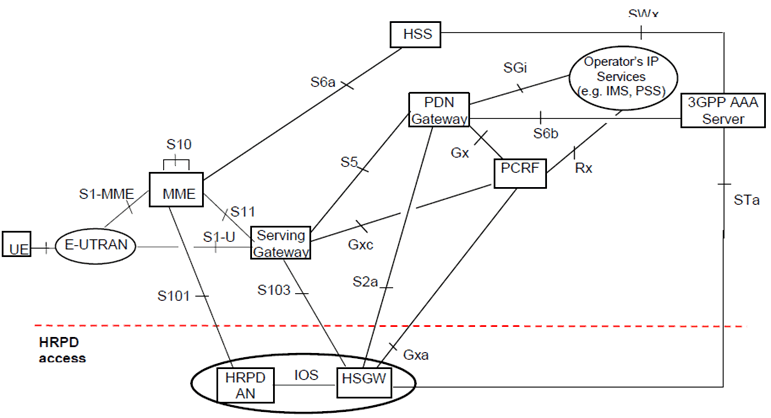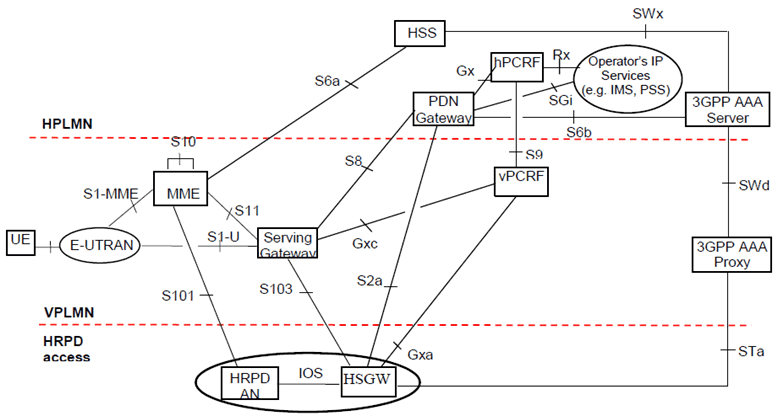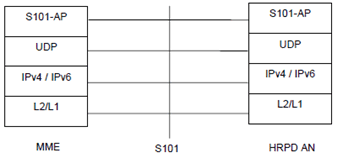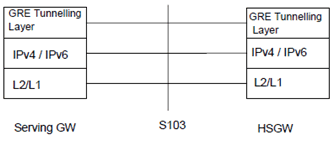Content for TS 23.402 Word version: 18.3.0
0…
4…
4.2…
4.2.2
4.2.3
4.3…
4.4…
4.5…
4.5.7…
4.6…
4.7…
4.7.2…
4.8…
4.8.2a…
4.9…
5…
5.2…
5.4…
5.5
5.6…
5.7…
5.8…
6…
6.2…
6.3
6.4…
6.4.3…
6.5…
6.6…
6.7…
6.8…
6.10…
6.13…
6.15…
7…
7.2…
7.3
7.4…
7.5…
7.6…
7.8…
7.10…
8…
8.2.1.2
8.2.1.3…
8.2.2
8.2.3…
8.2.6…
8.3…
8.4…
8.5…
9…
9.3…
9.4…
10…
13…
16…
16.1.2…
16.1.6…
16.2…
16.2.1a…
16.3…
16.4…
16.7…
16.8…
16.10…
17…
A…
C…
E…
9 Handovers with Optimizations Between E-UTRAN Access and CDMA2000 Access
9.1 Architecture and Reference Points
9.1.1 Architecture for Optimized Handovers between E-UTRAN Access and cdma2000 HRPD Access
9.1.2 Reference Points
9.2 Overview of Handover Procedures
9.2.1 General
9.2.2 Support for HO of IMS Emergency Sessions
...
...
9 Handovers with Optimizations Between E-UTRAN Access and CDMA2000 Access p. 224
9.1 Architecture and Reference Points p. 224
9.1.1 Architecture for Optimized Handovers between E-UTRAN Access and cdma2000 HRPD Access p. 224

Figure 9.1.1-1: Architecture for optimised handovers between E-UTRAN access and cdma2000 HRPD access (non-roaming case)
(⇒ copy of original 3GPP image)
(⇒ copy of original 3GPP image)

Figure 9.1.1-2: Architecture for optimised handovers between E-UTRAN access and cdma2000 HRPD access (roaming case; Home routed)
(⇒ copy of original 3GPP image)
(⇒ copy of original 3GPP image)
Depicted in Figure 9.1.1-1 is an access specific architecture providing support for optimised E-UTRAN-HRPD handovers. in the non-roaming case. Depicted in Figure 9.1.1-2 is an access specific architecture providing support for optimised E-UTRAN-HRPD handovers in the roaming case with Home routed traffic.
9.1.2 Reference Points p. 225
9.1.2.1 Reference Point List p. 225
S101:
It enables interactions between EPS and HRPD access to allow for pre-registration and handover signalling with the target system.
S103:
This User Plane interface is used to forward DL data to minimize packet losses in mobility from E-UTRAN to HRPD.
9.1.2.2 Requirements for the S101 Reference Point p. 225
The S101 interface supports procedures for Pre-Registration, Session Maintenance and Active handovers between E-UTRAN and HRPD networks. This is based on tunnelling over S101 signalling of one technology while the UE is in the other technology. The HRPD air interface messages tunnelled over S101 in E-UTRAN to HRPD mobility are defined in 3GPP2 C.S0087-0 [49].
The S101 reference point shall support the following requirements:
- HRPD and E-UTRAN/EPS messages shall be transported as opaque containers without modifications by the MME or HRPD AN.
- Messages may carry separate information IEs to indicate status, message types (e.g. handover command) forwarding addresses etc. as required by signalling procedures.
- Provide identifiers (i.e. S101 Session ID) to distinguish messages belonging to different UEs in order to allow responses originating from the target system to an UE to be appropriately forwarded to the UE by the source system.
- Reliable transport for S101 messages should be provided at the application layer and will not require transport layer reliability mechanism.
9.1.2.3 S101 Protocol Stack p. 226
The Figure below shows the protocol stack for the S101 interface.

Legend:
- S101 Application Protocol (S101-AP): It is the Application Layer Protocol between the MME and HRPD AN
- User Datagram Protocol (UDP): This protocol transfers messages. UDP is defined in RFC 768.
- S101 Application Protocol (S101-AP) provides application layer reliability for its messages, if required.
9.1.2.4 S101 Session Identifier p. 226
All S101 messages contain a S101 Session ID which serves to identify the UE context at the MME and the HRPD AN. The S101 Session ID uniquely and globally identifies the UE.
9.1.2.5 Requirements for the S103 Reference Point p. 226
The S103 interface between the Serving-GW and HS-GW supports the forwarding of DL data during mobility from E-UTRAN to HRPD. Signalling procedures on the S101 interface are used to set up tunnels on the S103 interface.
The S103 reference point shall support the following requirements:
- The S103 interface shall support the ability to tunnel traffic on a per-UE, per-PDN basis
- The S103 interface shall support Generic Routing Encapsulation (GRE) RFC 2784 including the Key Field extension RFC 2890. The Key field value of each GRE packet header uniquely identifies the PDN connectivity that the GRE packet payload is associated with.
9.1.2.6 S103 Protocol Stack p. 226
The Figure below shows the protocol stack for the S103 interface.

9.2 Overview of Handover Procedures p. 227
9.2.1 General |R9| p. 227
The S101 reference point, and E-UTRAN and HRPD access is used for transparent transfer of pre-registration and handover signalling between the UE and the target access system
The purpose of the procedures is to minimise the total service interruption time experienced at the UE, by allowing the UE to attach and perform service activation (in the case of E-UTRAN) or to perform a session configuration or traffic allocation request (in the case of HRPD) in the target access system before leaving the source access system.
In case where the UE is connected to the E-UTRAN and conditions are such that a handover to HRPD may be required, the source system provides the UE with sufficient information to perform pre-registration with the target HRPD access and core network, over the S101 tunnelling interface. If conditions subsequently warrant that a handover should occur, the handover signalling will also be performed over the S101 tunnelling interface. Once the UE is ready to connect to the target system, it switches to the HRPD access. Alternatively, the E-UTRAN may redirect the UE to HRPD using RRC Connection Release with Redirection Information set as specified in clause 5.3.8 of TS 36.331. If pre-registration has not been performed successfully, upon receiving the redirection message, the UE acquires the HRPD channel and performs the non-optimized handover according to clause 8.2.2 from step 3 onwards. If pre-registration is successful, upon receiving the redirection message, the UE follows the RRC Connection Release with Redirection procedure to reselect the HRPD cell according to TS 36.331 and then performs the idle-mode optimized handover procedure as specified in clause 9.4 from step 3 onwards.
In case where the UE is connected to the HRPD and conditions are such that a handover to E-UTRAN may be required, the source system provides the UE with sufficient information to perform pre-registration with the target EPS. The pre-registration may be performed over the S101 tunnelling interface. If conditions subsequently warrant that a handover should occur, the handover signalling may also be performed over the S101 tunnelling interface. Once the UE is ready to connect to the target system, it switches to the E-UTRAN access.
9.2.2 Support for HO of IMS Emergency Sessions |R9| p. 227
In order to support handover from E-UTRAN to HRPD of limited service state UEs, the following additional clarifications apply:
- When a limited service state UE without a UICC or with an unauthenticated IMSI, initiates emergency attach procedures for handover or initial attach to HRPD access to setup emergency sessions, the UE provides its IMEI during the attach procedure. The IMSI, if available, is also provided to the HRPD access by the UE during the attach procedure. If IMSI is not available or IMSI is not authenticated, an IMEI based NAI is used on the S2a interface in this case. Also, authentication with HSS is either skipped or if performed and fails, the HRPD attach procedure is continued.
- In the above scenario, for UEs that supports both E-UTRAN and HRPD access and handover is supported in the network between these accesses, the HRPD access selects a statically configured PDN-GW for the UE. This statically configured PDN-GW is the same as the statically-configured PDN-GW selected for the UE in E-UTRAN access.
- For optimized handover between E-UTRAN and HRPD for Emergency attached UEs in E-UTRAN without an UICC or with an unauthenticated IMSI, IMEI shall be used as the S101 Session ID to identify the UE within the MME and HRPD access nodes. If the IMSI is unauthenticated, the IMSI is provided on the S101 tunnel to the HRPD access with an indication that it is unauthenticated.